This article is specifically written on the subject of the level of S&C in boxing. It is not referring to MMA, Jiu-Jitsu or any other combat sport.
Honorary mention to the sports scientists in various countries performing fantastic work such as; blood work, MOXY (Muscle Oxygen Monitor), V02 max testing, etc; etc.
There are different levels in regards to Strength & Conditioning in boxing.
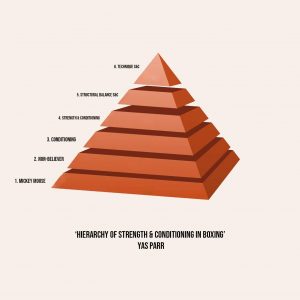
1) An attempt to incorporate S&C using ‘Mickey Mouse’ exercises with the goal of improving fighter performance. E.g. moving barefoot through a sandpit and throwing punches while being held back by a resistance band, resulting in not enough resistance to increase strength but enough to change muscle recruitment, biomechanics and so alter technique. These coaches like to add bands anywhere and everywhere, there are videos all over the internet of even top fighters doing silly stuff with bands in an attempt to enhance performance.
Should bands be used? Yes, if accommodating resistance is programmed.
If bands are used it should be when performing resistance training in the gym, generally extension exercises which have an ascending strength curve, i.e. bench press, squat, deadlift etc. They are for experienced lifters as the boxer will be working against hyper-gravity.
Whilst those looking to gain an edge by using different ways to train can be commended, make believe exercises such as these are very, very poor. The only positive thing about coaches doing this stuff is they acknowledge S&C and are making an effort to physically improve their fighters. Unfortunately this stuff is so bad, not only does it not achieve the results looked for, but it has a negative effect on technique and is actually inferior to doing no S&C.
2) Those that think S&C might work for other sports but not boxing. Or, that it’s bodybuilding and makes boxers bulky and slow. This is the very lowest level of understanding the benefits of S&C for boxing. However, I have placed it higher on the pyramid because boxing training without a doubt is the best way to improve boxing ability. The exercises done at Level 1 are bad for performance.
3) Circuits that use sleds, battle ropes, inertia wave etc; programmed in order to replicate the timing of rounds.
This form of training can legitimately be called ‘Conditioning’ but it is definitely not ‘Strength & Conditioning’. ‘Strength’ should not be in the title if there is not specifically programmed training with the goal of radically increasing the fighter’s strength.
‘Strength is the mother of all qualities’ (Dietmar Schmidbleicher).
‘When in doubt, if you get stronger you will be better’ (André Benoit).
‘Strength is the ONE physical quality that enhances all aspects of performance’ (Josh Bryant).
Something that I have said and written myself in the past is ‘If a fighter is strong then everything else is easier, he/she will always be working at a lower % of their maximum’.
There are obviously benefits to this type of circuit training for a fighter. Whilst not ideal, this is a massive step in the right direction when compared to lower levels.
4) S&C to improve power, along with a superior engine and the ability to display an undiminished level of strength and speed in the later rounds.
This is pretty much the minimum level needed for adequate performance enhancement. Any legit Strength & Conditioning Coach can come in at this level whether they have previous experience of working with fighters or not. It’s much better to bring in a qualified S&C Coach with experience of training elite athletes from other sports yet no experience of training prize fighters, it would be a superior choice over an unqualified individual with several big names on his/her C.V./Resumé.
Having the knowledge needed to improve athletic ability will cover 80-90% of performance needs, the remaining 10-20% comes with an increased knowledge of the physical attributes required for boxing.
5) S&C that is designed to not only improve athletic ability in general but also to identify physical issues in the individual that inhibit optimal performance. If these issues are not addressed then the training of tier 4 will not generate the level of results that could be achievable.
As with Level 4, plus training to improve the individual’s imbalances as well as performance enhancement.
6) S&C to correct both physical and technical weaknesses.
This level of S&C takes the ability to increase athleticism, i.e. make the boxer stronger and faster, combined with working on the individual differences (Level 5) that hold back the progress made from the standard performance training (Level 4), and adds to this S&C that corrects technical weaknesses.
Some of these are not difficult to see and can be seen by the S&C Coach when viewing videos of training or actual competition.
Much needs to be identified by the experienced eye of the boxing trainer in regards to which technique needs improving. Often an improvement in a technical aspect can be identified by the trainer but the fighter struggles to make the changes needed.
Suitably selected exercises can go a long way in improving what the trainer is looking for. The key here is identifying these exercises and incorporating them into the boxer’s training at the most suitable stage in order to have the biggest positive impact.
Now we will expand on Level 2, hopefully it goes a little way to helping ‘Old School’ boxing trainers understand the benefits of S&C for fighters.
The following is an Emanuel Steward interview with Mike Silver taken from Silver’s book ‘The Arc of Boxing: The Rise and Decline of the Sweet Science’.
“Many weight trainers and conditioners confuse the training techniques needed for boxing with the strength training needed for (American) football and other physical sports in which strength training has been utilised for many years.
I am very upset about having these strength coaches involved with professional boxers. Shannon Briggs had a weightlifting coach that messed his shoulders up. You can throw 95 percent of them in the alley as far as I’m concerned. When it comes they don’t know what the hell they’re doing.
Recently we were interviewing Fernando Vargas for HBO and he says, ‘Look at me here, you never saw a Mexican cut like this.’ He was so excited talking about his impressive looking physique and his strength trainer and nutritionist. When we finished up interviewing I said to him ‘Fernando, are you doing any boxing? – Because this is all you’re talking about’. He was so wrapped up into his strength training and nutrition program that he totally lost focus that he was a boxer. I felt he definitely handicapped himself.
Look at Tommy Hearns, Bob Foster, Joe Louis and all those great punchers. They are usually rangy guys. Even (George) Foreman was a loose naturally strong kid. They didn’t have these tight muscle builds that came from lifting weights. I looked at (Fernando) Vargas after the sixth round of his fight with Oscar (De La Hoya) and realised he wasn’t even reacting. He couldn’t even block punches, couldn’t even move his arms to pick them off. When they ended up stopping the fight Oscar was pouring it on and Vargas was up against the ropes with his hands up but he couldn’t defend himself. And that’s what the weightlifting does. It gives you that temporary feeling of being strong with your push punches.
Weightlifters don’t have good punching power because they push their punches. They look strong but they don’t really punch hard. And they tire very quickly. So far as I’m concerned they can give me my old methods whereby a fighter gains physical strength by boxing with another guy his own weight, exchanging punches, blocking punches, pushing each other, going to the ropes. You develop the necessary strength from dealing with that.
Most fighters are already naturally strong. Are you telling me the old methods of beating on those heavy bags, skipping rope, hitting the speed bag and such – all of a sudden that’s outdated?”
Unfortunately this very outdated view seems to be a lot more common in some countries than others.
Whilst no doubt it’s undeniable that Emanuel Steward was one of the best boxing trainers to ever grace the sport, there are a lot of things wrong with what was said in this interview. So let’s dissect it a little.
‘Strength training needed for (American) football and other sports’…Improving an athlete’s athleticism will pretty much benefit those of any sport, assuming we are talking about a sport that’s actually physically demanding and not talking about sports such as darts, chess etc. Also, just because someone lifts weights it doesn’t mean that their training is anything like that of another sport, especially as competition nears.
‘Shannon Briggs had a weightlifting coach that messed his shoulders up’…If this is true then that was a very poor coach. Assuming that it was a qualified weightlifting coach, that still doesn’t mean that it was a strength & conditioning coach. Saying that, a weightlifting coach that is qualified and experienced would not injure a boxer’s shoulders, this would only happen if there was already a shoulder problem that the coach was unaware of. Even if the weightlifting coach had no experience of working with athletes from other sports, they would still be able to produce significant improvements in the power of a boxer.
‘You can throw 95 of them in the alley’…Unfortunately most of the S&C work done with boxers in the U.S. is done by personal trainers, fitness enthusiasts etc. Even having someone qualified in a related field doesn’t guarantee adequate knowledge on the subject if it’s not there specialty. If legit, qualified, experienced coaches were employed then the numbers would be the exact opposite, e.g. 95% would be doing a great job.
I have no idea who was working with Fernando Vargas but him being lean is by no means any kind of indication that his strength & performance training was at a high level. I’ve seen lean anorexic teenagers with good abs.
Obviously if the guy was replacing his boxing training with resistance training then that would be a mistake. Personally, I’ve never heard of that. Skill training for the sport should always be the athletes priority.
‘They didn’t have these tight muscle builds that came from lifting weights’…Again, this is a lack of understanding on what strength & conditioning is. Of course you can train with weights and become bulky, slow and lack mobility. However, any coach worth his salt would not train a fighter to have these traits. Even if the individual needs to add muscle to move up a weight class, even then some areas should be targeted over others. Training through a full range of motion results in an increase in flexibility not a decrease. A good example would be an Olympic weightlifter, having both explosive strength and a high degree of joint mobility.
WEIGHTLIFTER (EXTREME STRENGTH & MOBILITY)
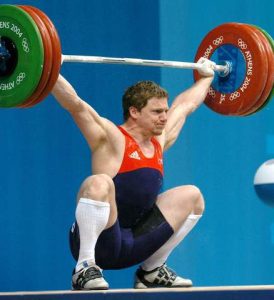
There are many ways to utilise resistance training and so the correct approach must be taken. Powerlifting is nothing like bodybuilding, bodybuilding is nothing like training for sports performance.
‘Oscar was pouring it on and Vargas was up against the ropes with his hands up but he couldn’t defend himself. And that’s what weightlifting does. It gives you that temporary feeling of being strong with your push punches’….
It’s difficult to comment on this one. Weightlifting, maybe should be better worded as ‘resistance training’, assuming we’re not talking about the Olympic sport of weightlifting, does not give you a temporary feeling of anything. A training session geared at creating muscular growth will cause a ‘Pump’, whereby the targeted muscles are filled with blood, this will give a temporary appearance and feeling of being bigger. Strength gains from resistance training are genuine and as long as training does not cease and so detraining result, then strength gains will be ongoing.
‘Weightlifters don’t have good punching power because they push their punches’…Weightlifters, as in the sport of weightlifting, have incredible explosive strength, they are faster over a short distance than a sprinter and second only to high-jumpers when it comes to jump height. They are not boxers and if an athlete from this sport cannot punch well it’s because they have not been taught to punch well.
‘They tire very quickly’…Only when conditioning has been neglected, the same as any other fighter.
As far as Vargas goes with De La Hoya, if he was training with some coach in a way that has a negative effect on sports performance and missing boxing sessions then fair enough. One thing’s for sure, if a fighter is training with a legitimate S&C coach in order to become stronger, faster and have the ability to display these values for longer, then it can only make him/her better. There’s not a chance on this earth that it would make him/her worse.
Even long distance runner Paula Radcliffe who’s marathon world record set in 2003 was on an excellent S&C programme whereby she performed exercises such as heavy barbell back squats. This world record still stands two decades later. Obviously neglecting running training in favour of strength training would’ve been a mistake, S&C should be incorporated into the whole schedule.
‘Old method…’ These things are going to improve a fighter’s boxing ability in many ways, in relation to strength they are only going to improve it at the onset. Obviously we are not talking about boxing ability here, we are talking about athletic ability.
Boxing will always make you better at boxing because it conforms to the S.A.I.D. Principle:
S – Specific
A – Adaptation to
I – Imposed
D – Demands
However, whilst improving technical ability can generally continue for longer, once a full grown adult, performing the usual boxing training will not cause an increase in athletic ability because it does not adhere to the ‘Overload Principle’. The overload principle means that an individual needs to do more than the body’s accustomed to in order for adaptation and progress. This is where structuring performance training using periodisation is needed for guaranteed, continuous progress.
The different factors needed to create overload when banded together are known as the F.I.T.T. Principle:
F – Frequency
I – Intensity
T – Time
T – Type
For a novice it’s easy to incorporate the overload principle using boxing training (including running etc.) alone. For the more experienced fighter this becomes difficult with the exception of switching out sparring partners every few rounds while the fighter does all rounds against continuously fresh opponents. Doing this will only improve muscular and cardiovascular endurance, which are obviously two vital components of what’s needed for a boxer, however, they are only a portion of the ideal. Strength produced quickly is power, you cannot generate great power if you are weak.
‘Most fighters are already naturally strong’… This is incorrect, they are stronger and fitter than they would have been due to hitting a heavy bag, running etc. Skipping rope is excellent, it’s a form of plyometrics, but it’s only any kind of ‘workout’ for the inexperienced, for somebody with a decent level of ability and experience it’s pretty much just an exercise for warming up the ankles. Again no use of the overload principle.
Everyone has seen boxers that couldn’t crack an egg. There are actually top level fighters, even champions that are technically excellent who are severely lacking strength. If a fighter has a low knockout percentage then training to be stronger should be the absolute priority. What may seem obvious to some is not to others.
Power translates to ‘High Velocity Strength’. Basically, strength produced very quickly, the key word being strength, without strength there is no power.
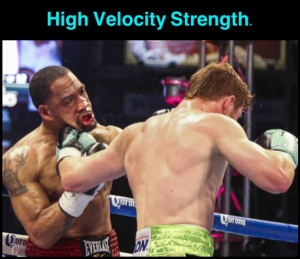
I’ve seen plenty of boxers that are ‘almost’ top level, some have even fought for a world title. These boxers tend to have boxing trainers that are of the opinion that ‘Lifting weights makes you slow’, or even ‘It works for other sports but not for boxing.’ If for example a fighter, let’s say twenty seven years old who has been boxing for twenty years and has reached a high level, this boxer has never used a qualified strength and conditioning coach for the purpose of performance enhancement. If this is you, what are you going to do next? Just carry on carrying on? What got you from point ‘A’ to point ‘B’, will not get you from point ‘B’ to point ‘C’.
A Strength & Conditioning Coach messaged me asking ‘What are your thoughts on Tyson Fury saying he doesn’t need to do weights?’
My answer was, ‘He doesn’t need to lift weights to be better than everyone else, but he does need to lift weights to be the best that he can be. Depends what goal he’s happy with.’
Now let’s expand on Level 5 a little, here we will use Deontay Wilder and Tyson Fury as examples.
Deontay Wilder

Besides S&C training to improve strength and rate of force development (RFD). There are other things here that demand serious attention. Anyone can see that Deontay Wilder has extra skinny legs, this is a serious handicap to him. Wilder is the hardest hitting heavyweight there has been in a long time. But could he hit harder? Absolutely!
There’s an old saying ‘You can’t fire a cannon from a canoe’, but that’s the thing, Wilder can. Force is generated from the floor, so if Deontay Wilder trained his lower body to add both strength and size to his legs, he’d be launching a nuclear warhead not a cannonball. Trained legs would also enable him to take a bigger punch too due to him having a stronger, bigger and more stable base of support.
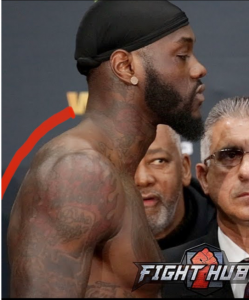
If we now look at the poor posture shown in the above photo, not only does the highlighted area show weakness, but with this bad posture there is also the added difficulty of rotating efficiently, which then becomes more energy consuming.
Tyson Fury

The majority of people look at Tyson Fury and would say that he needs to lose fat. This is both true and obvious, some would say he needs to lose fat and add muscle, this is also true and obvious.
On top of training to be stronger and faster there are also other things that can be seen if we look at him more as an individual, things that would have a huge impact on physicality.
If we look at the above photo we can see that the heads of his femurs appear to be internally rotated. Now this can’t be corrected and not only should it not be attempted but it’s something which I suspect to be beneficial for a boxer, just as the opposite (externally rotated heads of femurs) seems to be beneficial for a wrestler/grappler. It is very common and is not a big deal, it just looks more aggressive due to the length of Fury’s legs.
If we look further we can see that he has what appear to be collapsed arches (flat feet), which tend to go hand in hand with internally rotated femurs. Over the years I’ve seen a correlation between flat feet and weak glutes. This was confirmed during a conversation with Professor Jeff Casebolt, who is the Director of Biomechanics Research for Dynamic Multi-Directional Resistance Systems, who shared that he has a ton of research on the link between flat feet and a weak posterior chain.
Boxers at a high level who possess flat feet tend to have very good footwork. If the musculature of the feet and ankles, which have a massive effect on athleticism are trained, then improvements in posterior chain recruitment and so development will be considerably noticeable in both appearance and power development. Training these muscles will not have a negative effect on footwork as these patterns have been engrained over many years.
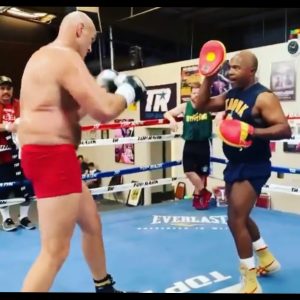
If we strip away the fat, Fury does have a decent amount of muscle but obviously he could do with more. This is most easily viewed if we look at his minimal glute and hamstring development, two muscle groups that have a massive influence on power generation.
There’s no denying that Fury also hits hard, technically excellent and weighing 270 lb ensures this, however hitting hard for those reasons and hitting HARDER because he has trained specifically to add power takes it to another level.
Muscle is often seen by boxing trainers as a hinderance to optimal performance . However, if the right amount of muscle is added to the most appropriate body parts and this muscle is added in a correct way in order to avoid a negative effect on technique and at the same time enhance athletic performance, then not only will this added muscle not be a hinderance but it will have a profound positive effect.
It’s amazing that some boxing trainers will even prefer their fighter to be fat than discuss anything to do with adding muscle. At least muscle is contractile and has a function when it comes to movement, fat for a boxer is nothing more than than a dead weight handicap.

Unless Fury specifically trains the muscles of the ankles and feet the benefits of training the posterior chain will be minimal, with most of his lower body training being dominated by lower back and quad recruitment.
I’ve used these two active heavyweights as examples as it’s easy to see physical issues that have a negative effect on performance without going too much into detail. I would be surprised if both fighters do not suffer from lower back pain.
If you’re an individual of the opinion that S&C is not good for boxing, i.e. making a boxer stronger and more powerful is not beneficial. If this is your way of thinking then ask yourself ‘If a prime Mike Tyson would have been slower and weaker, would he be better or worse?’ This is saying nothing about Tyson’s training, I am simply emphasising the fact the when it comes to prize fighting more power is never a bad thing.
Sometimes people speak to me about a certain fighter, how good he was and how he didn’t lift weights. My answer is always ‘Imagine how good he could’ve been.’
A scenario to imagine is if we were able to take identical twins, all else being equal e.g. boxing ability etc; and trained one with high quality S&C for a year, the other carried on with their normal routine. As long as boxing training was not neglected, without a shadow of a doubt the fighter training for performance enhancement would destroy his twin. If all else being equal then the twin that can hit harder, faster, and not lose intensity in the later rounds, with the added benefit of being more injury resistant and also conditioned to absorb force better, then this twin would obviously be superior to his sibling.
My S&C professor at University once told me the story of two tennis players Jim Courier and Pete Sampras, both players were competing equally and winning tournaments. One day Sampras saw a video of Courier’s training and decided to also add strength and conditioning to his training. You see, Courier was physically superior while Sampras was technically superior, once Sampras upped his athletic ability then it was game over for Courier, Sampras had surpassed his main competition.
At this present time a boxer can indeed become a champion without strength and conditioning being included in their training schedule. However, dependant on geography more and more fighters and trainers are receptive to the benefits of suitably programmed resistance training and at some point just like in other sports, those that don’t train to become stronger and better conditioned will no longer be able to reach the very top level.
